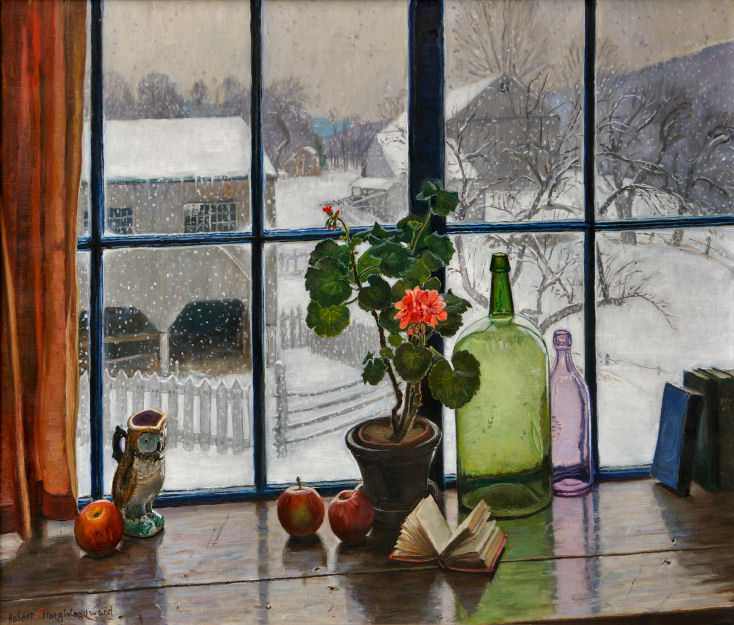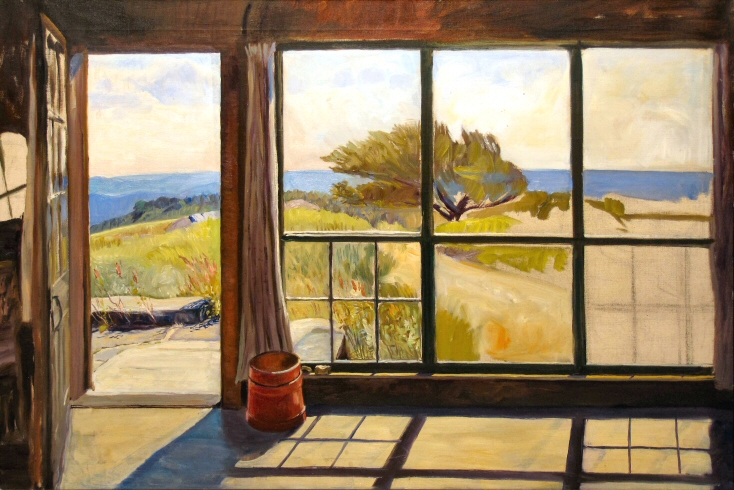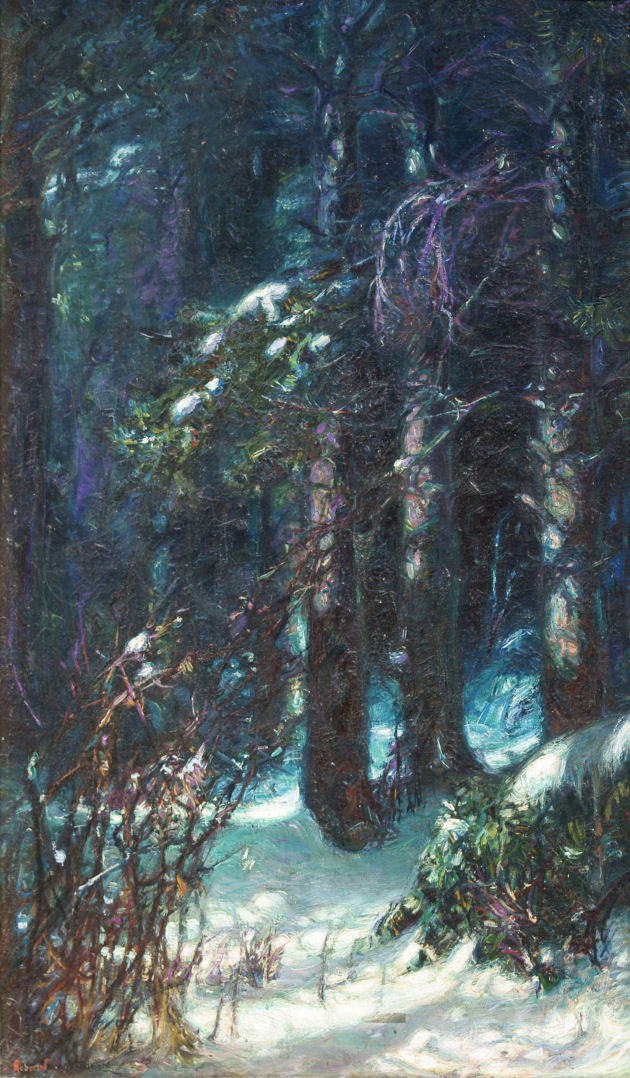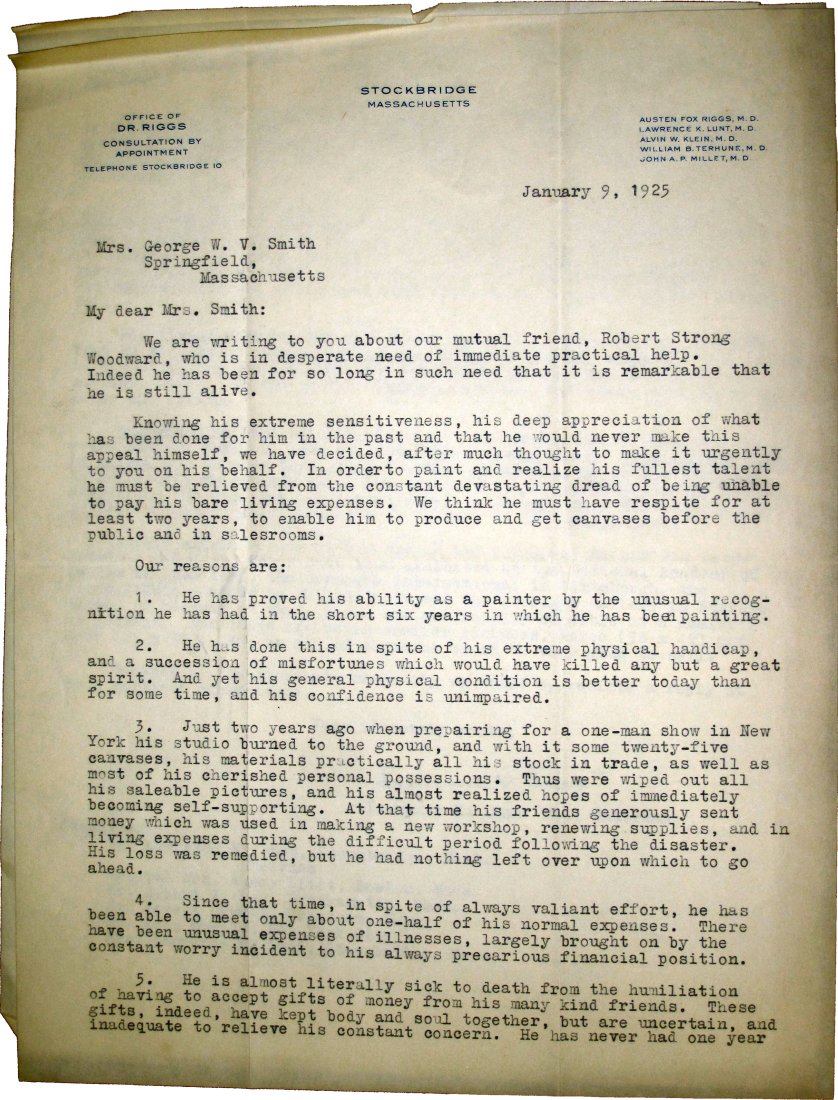The Evolution of the Window Picture Painting, part 1

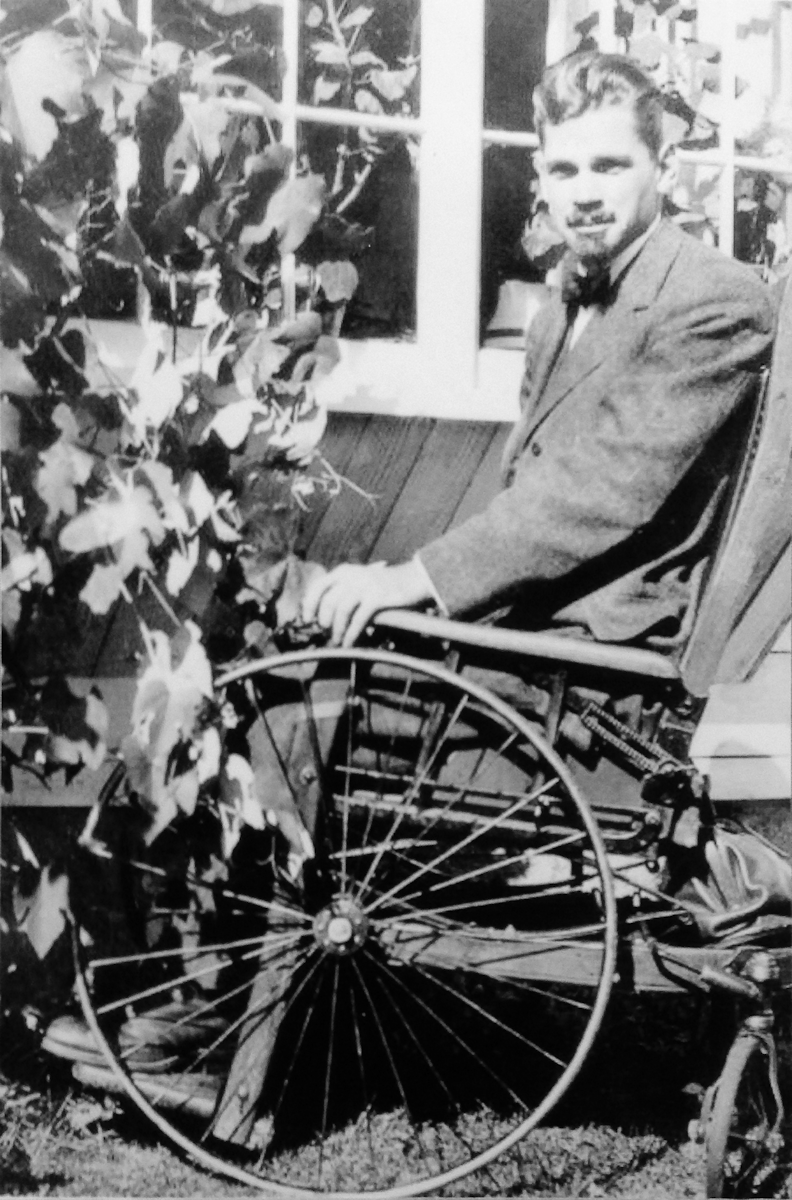
 A picture of RSW along side the only
A picture of RSW along side the only
bay window on the Hiram Place - 1920s
THE LOOKING-GLASS: Insight to a Revealing Truth
There is perhaps no other style or form of painting more identifiable to Woodward than the "Window Picture" painting. They are immediately recognizable and associated with the artist. Their uniqueness and originality are strongly connected to his brand. Today, they rarely come up for sale and when they do they are highly coveted. Although most all of his Window Pictures were painted after he had established himself as a nationally recognized landscapist their origins can be traced back to the earliest days of his career and further.
What makes them so special to his brand is their reflection of his perspective playing out in a number of ways. First, they demonstrate Woodward's practice of combining seemingly opposite and contrasting perspectives, that of the still life with the backdrop of a landscape portrait. Second, the Window Pictures reveal much more of his personality to the general public. An attitude or "outlook" if you will. The paintings allows the viewer a peak inside his inner world. Third, the paintings reflect his strong sense of home and the safe confines within that serve as a retreat when perhaps the outer elements do not permit one to venture out. They are his most revealing and intimate paintings for as private a person as he was.
Woodward was an avid collector of things. The Window Picture also reflects his love of, appreciation for, and attachment to the items he collected over the years. Many of these items are old handcrafted brick-a-brack of glass and ceramic pieces with the imperfections that come with being handmade using age-old traditional techniques now being displaced by the modern mechanized era of the post-industrial revolution. For an artist who avoided sentiment in his landscapes, these items are very sentimental and in many ways honors another time and is perhaps a commentary a changing society. With this being understood, it is another example of Woodward combining two contrasting qualities of sentiment without compromising his values or principles in keeping faith to his brand as a landscapist. A balance for which he aspires to the most uncompromising way.
In this essay we hope to take you through the influences and development of the Window Picture. We will start with its origin and the intimate nature assigned to their significance and how the original resembles what they will later become. We will show you how they evolved and yet stayed remarkably truth to their origins. We will explain that while there technically are no Window Picture Paintings from his first studio Redgate. He was doing something very similar with his dusk-laden, atmospheric, wooded interiors including the symbolism that connects them to the studio's name and later the Window Pictures. From there we will show you the factors we believe brought the Window Pictures to fruition with his first professional painting from his second studio, the Hiram Woodward Place.
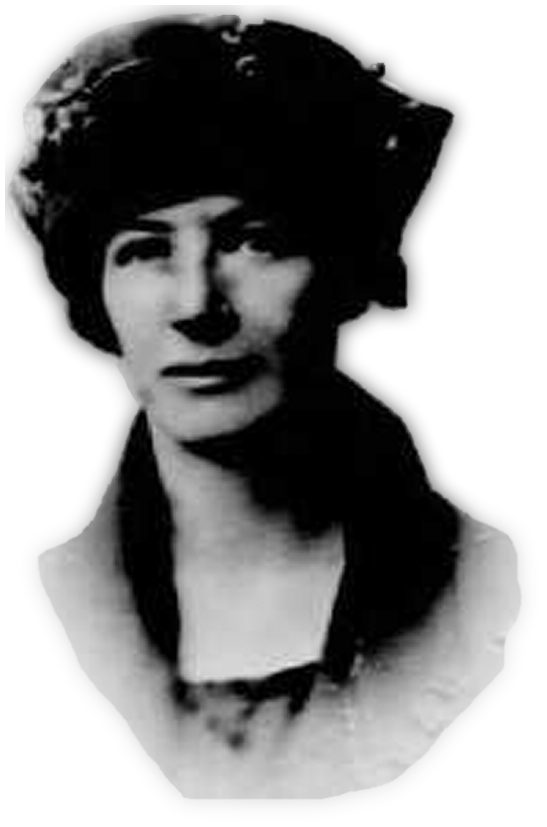
 From Helen Ives Schermerhorn
From Helen Ives Schermerhorn
passport photo, 1920
IT BEGINS WITH HELEN: An Intimate Relationship
The earliest Window Picture we know of is a pencil sketch at the end of a letter to Woodward's friend Helen Ives Schermerhorn from his Boston apartment while attending the Museum of Fine Art School (MFAS). It is his "barren student's room" window with, a single curtain, a pink primrose planted in what he describes as a brass pot accompanied by a crucifix hanging on the frame casing to the potted flower's right. The window itself is reminisent of the small east facing window in his Southwick Studio. The potted plant, religious icon and single curtain pulled to the right are all common items found in his later stage Window Pictures.
From the letter to Helen:
"My brass jar, I must tell you is a vast comfort to me - I brought nothing of the kind with me of course - and find that the brown weed grows dry in this climate. The jar rests as the one bit of refined beauty in my barren students room - no, I have a pink primrose in a pot on the broad white windowsill -- with above it an ebony and silver crucifix."
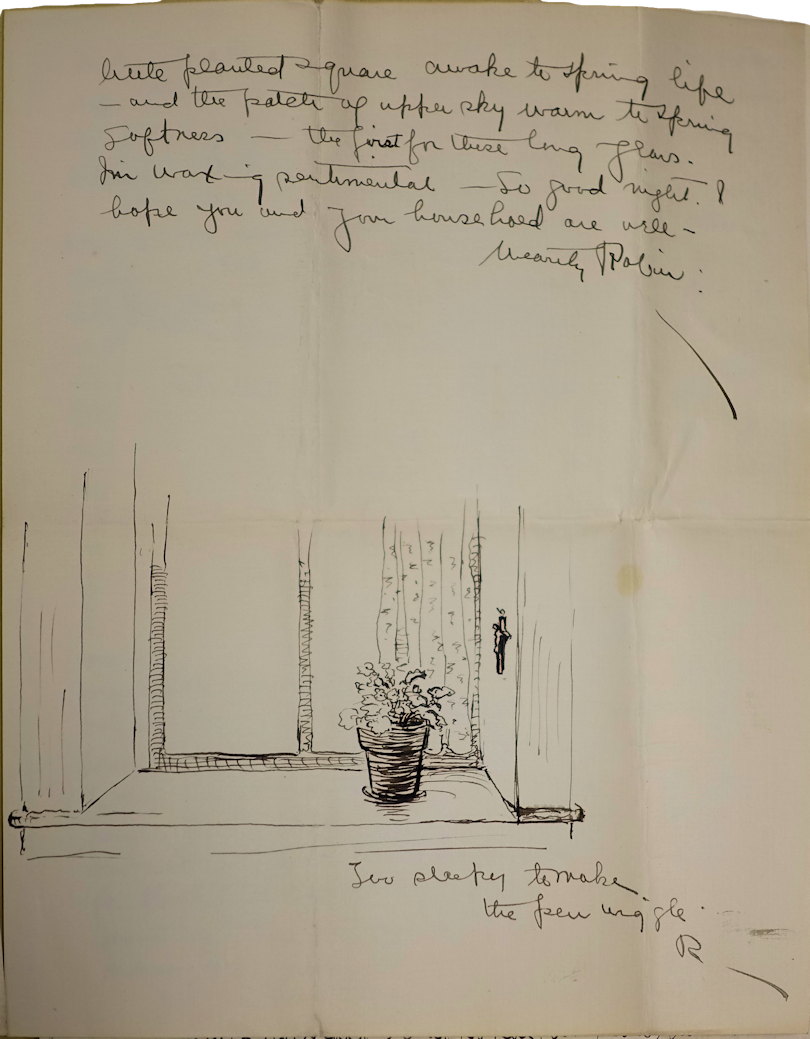
 Boston Apartment Window Drawing
Boston Apartment Window Drawing
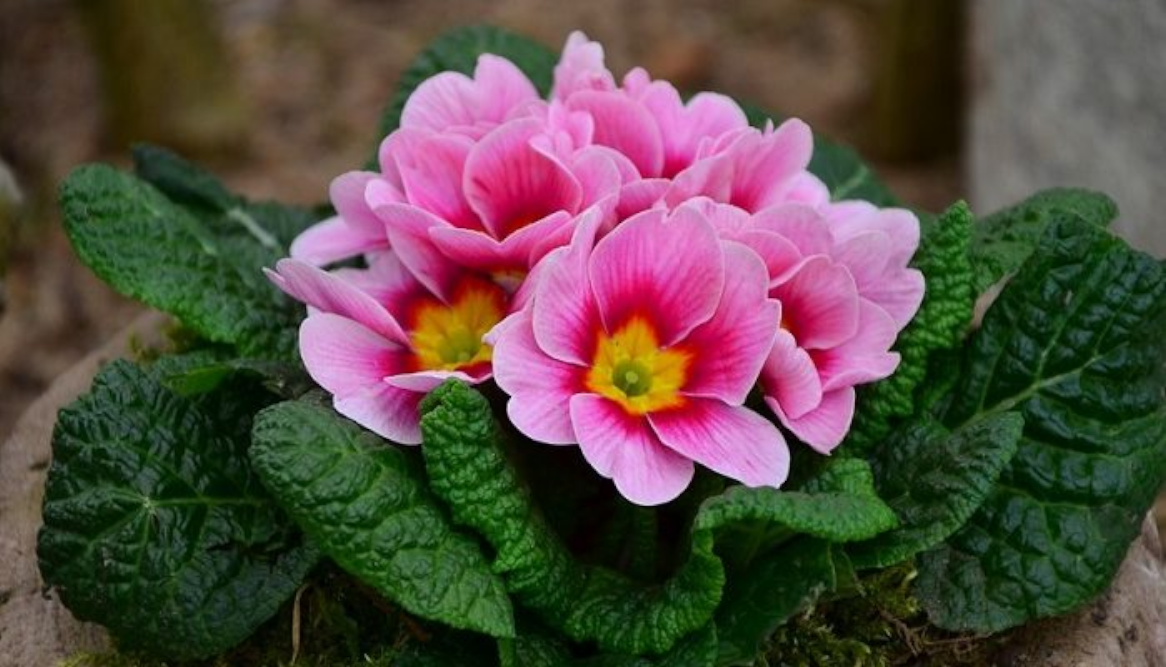
 A Pink Primrose
A Pink Primrose
He starts his letter by telling Helen he has been ill but getting better. Note how he finds refuge in this "one bit of refined
beauty" and that the flowering plant is struggling as well. One can sense that he finds comfort in this sentimental decor. It is equally important to note that Woodward is going through a phase
transition. He is in school and it is not going well for him. He is reflective, vulnerable and, even may be uncertain of his future and possibly facing misfortune - again.
Woodward is awfully tired
when he scribbles this drawing for Helen. Underneath it he writes, "Too sleepy to make the pen wiggle. R". What is missing from this drawing is any of the scenery or the view from outside and so
technically it lacks the criteria to be considered a true Window Picture. We will discuss this criteria later but we would be remiss if we did not also point out that RSW gave Helen a glowing description,
full of promise for the future, of the exterior outside:
From the letter to Helen:
"This window looks out upon the shrubbery of a most
lovely little courtyard, shut from the narrow street by a quaint, old fashioned and high iron grating with double gates. Old time birch flats - warm in color and romance line our little narrow street.
Joseph [Cowell] and I alone use this goodly courtyard, 'cause 'tis the side entrance and a bit around the corner from the practical way.
How I shall love to see the shrubbery of
my little planted square awake to spring life - and the patch of upper sky warm to spring softness - the first for these long years. I'm waxing sentimental - so good night. I hope you and your household
are well -
Wearily, Robin"
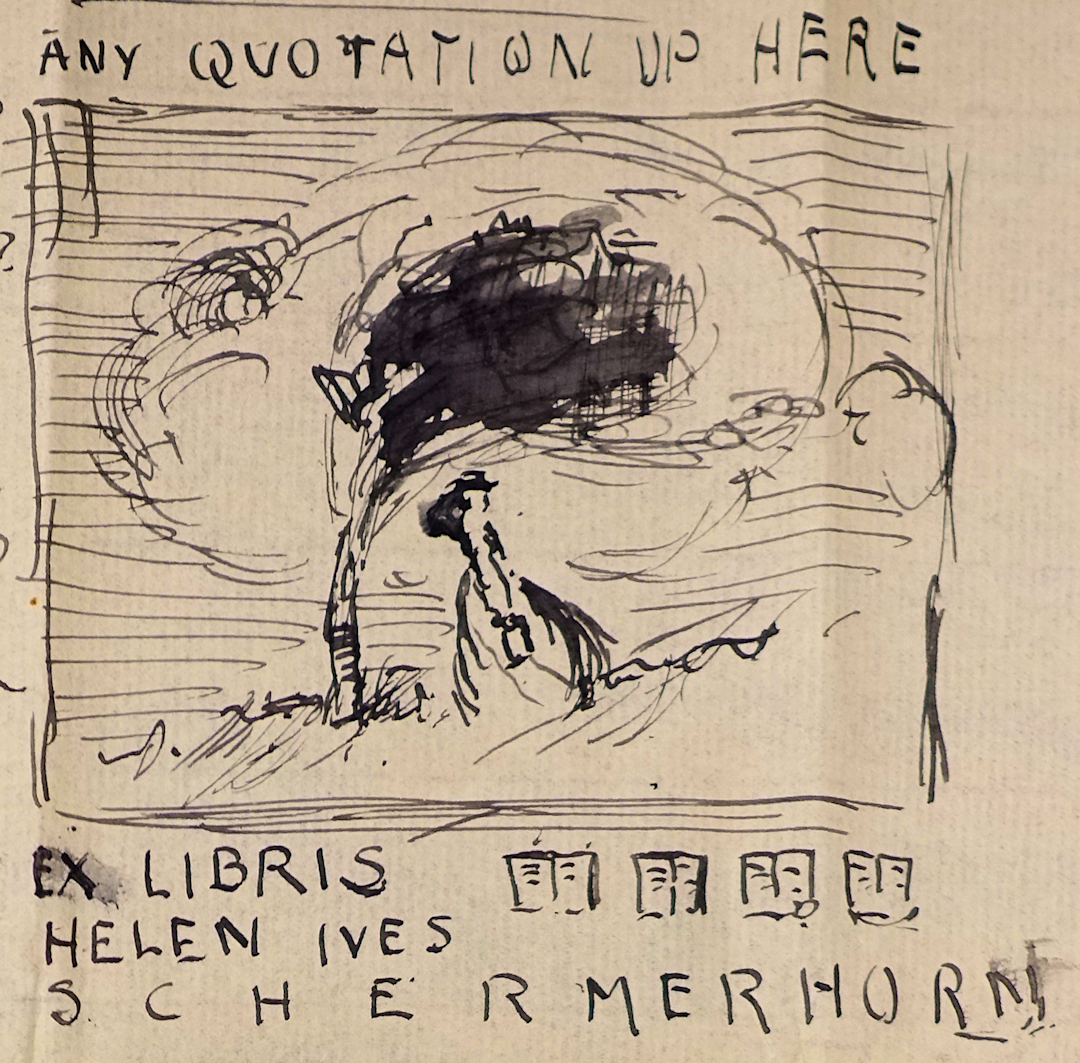
 Woodward's doodled concept for
Woodward's doodled concept for
Helen's bookplate made before he went to
Boston... To see the letter CLICK HERE
Again, this was drawn in what is best described as a private and very personal moment. He is ill. It is colder outside further
restricting or at the least making travel difficult and uncomfortable and maybe even ill-advised. In many ways, he is homebound. Seeking solice, he finds it in something simple, a potted plant in a
brass jar he has some affection for, and expresses what a comfort it is to him. But what really perks him up is the promise of spring and being outdoors in the confines of the courtyard and his plant's
seedlings coming to fruition. In this sense, the window becomes a portal into the future. It holds the promise of better days ahead and in a sense reveals just how much of a romantic Woodward is.
We get most of Woodward's most personal and honest thoughts through his letters to Helen. Their relationship is such that he reveals himself to her more than he does even in his own personal
diaries. Helen is an intellectual. Someone he can engage and share things with that perhaps after his accident became more private. As it would happen, Helen again would play a leading role in the
early origins of what would eventually become a blueprint for his Southwick Window Paintings. Helen's influence will appear two more times in relation to the Window Picture.
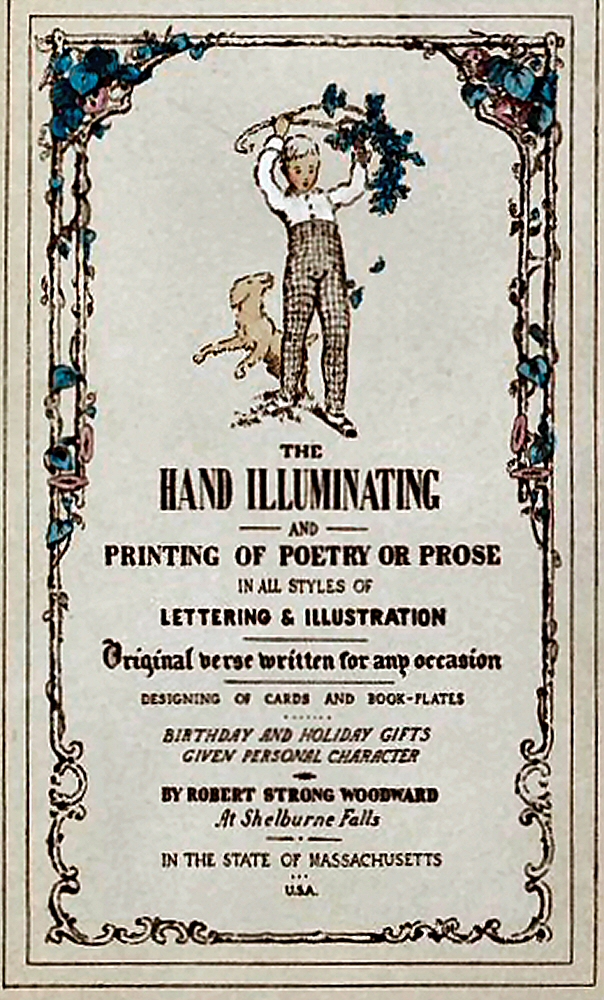
 Woodward's business card, 1910s
Woodward's business card, 1910s
BY DESIGN: An Illustration is a Window
Going back before he attends school, two years after his accident, we know Woodward is still in Southern California.
We learn in a letter to Helen he is earning his own money designing custom bookplates, also referred to as "Ex Libris" meaning "From the Library of..." These are small vanity card-like personalized
labels glued to the inside "paste-down" page of a book's cover board identifying books as part of person's personal book collection. The plates/cards are designed specifically to capture the
personality and interest of the book's owner. One can also call them elaborate logos.
After his ruinous attempt to go to art school in Boston that leaves him living with family in
Buckland, MA. He picks up the trade again to earn enough money to support himself and his high medical expenses. This time as a professional commercial artist. Only now he really commits
himself to the endeavor, designing a business card and having an unused dairy shed on his aunt and uncle's property converted into a studio (Redgate). He had propositioned Helen years earlier
to make her a personalized bookplate while she was still in school and he in Los Angeles but we imagine she passed on the opportunity if for no other reason, then we think she may have thought
it perhaps presumptuous or pretentious or maybe premature for a student who has yet to make her way in the world to subscribe to such vanities.
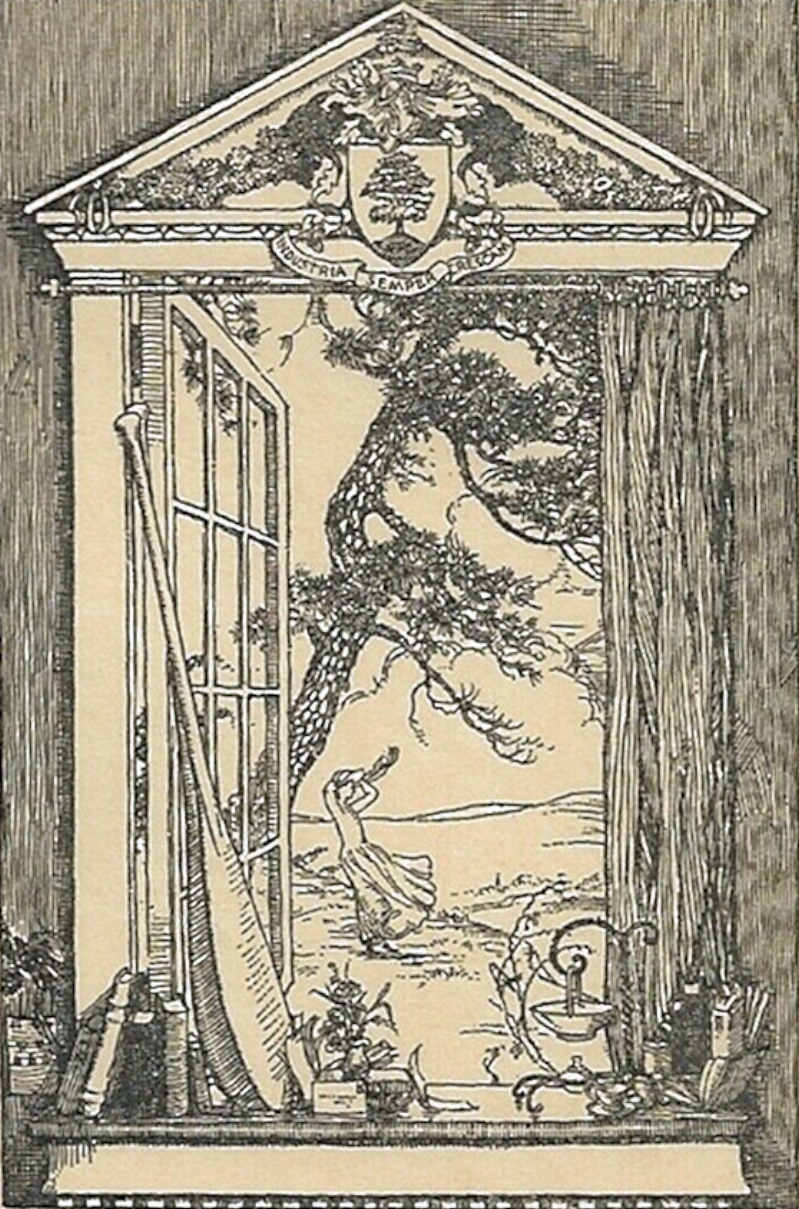
 Artwork from Helen's bookplate...
Artwork from Helen's bookplate...
Are those two canoe paddles canoedling?
Still, Helen was highly aspirational and after years of teaching she was about to further her education at the graduate level
at one of the only schools at that time to offer such opportunities to women, Bryn Mahr College. She eventually relented and allowed RSW to design her bookplate. After all she is a bibliophile like him.
It is remarkable how much Helen's bookplate resembles the aestetic and form of his later Window Pictures. The two differences being Helen's appearance in the landscape outside the window holding
on to her bonnet in the strong blowing wind at her back (very symbolic of one with a favorable future) and the window is open. Note the similarities to the Boston window's single curtain to the right side and the small
potted flower roughly in the center. But it is the inclusion of the personal items that make it distinct. To the right appears to be a basket containing a book, and a fan, as well as what appears to be a
bottle of some sort. Next to that moving left in the image is a tea cup in front of what we imagine is a metal jewelry stand popular at the time with a bowl to hold her rings or jewelry and below that a
place to hold a bottle of perfume. All the way to the left, is another potted plant, maybe a geranium, and to its right a collections of books.
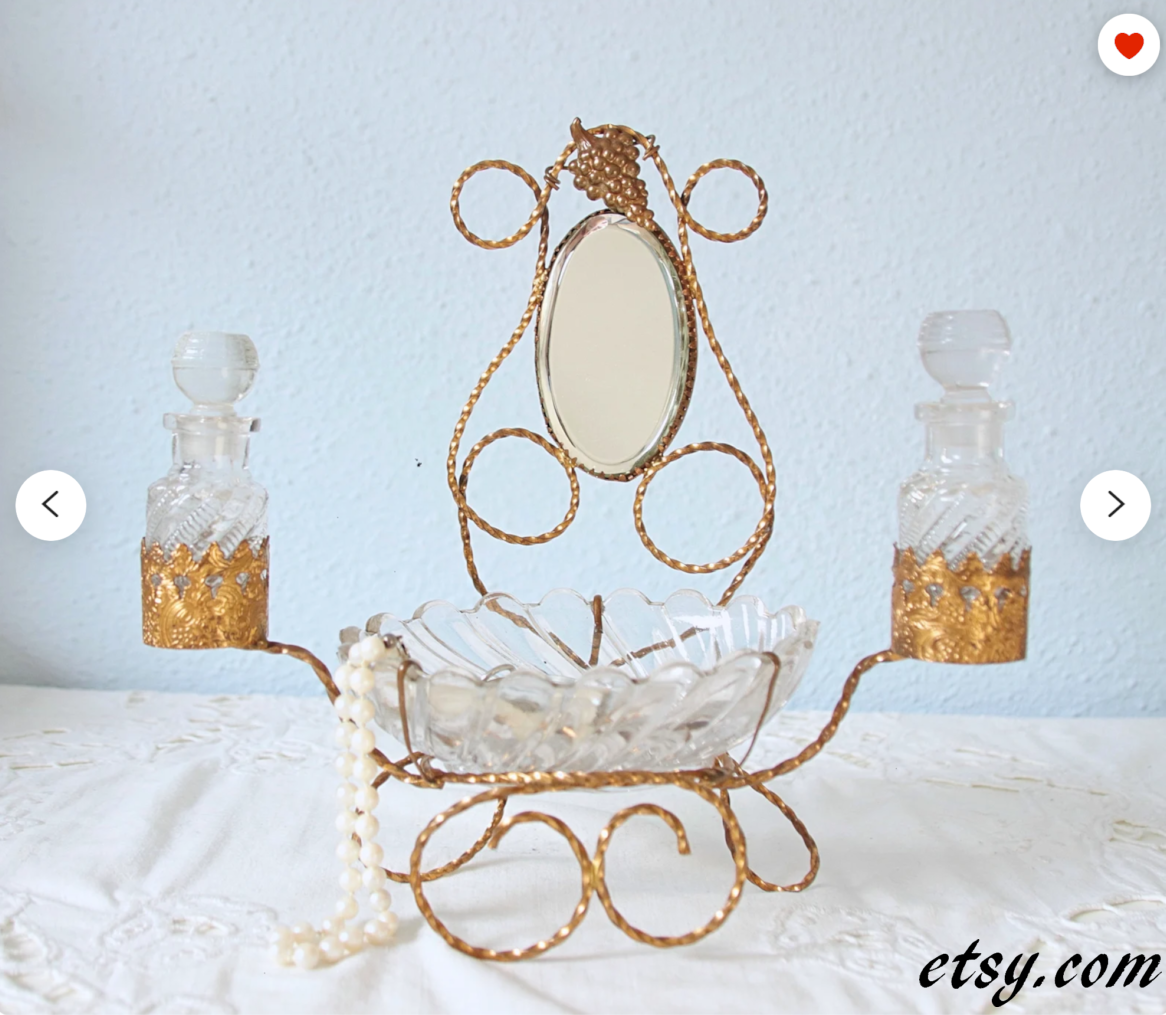
 Vintage 1910's Metal Jewelry/Perfume
Vintage 1910's Metal Jewelry/Perfume
Stand easily found on the shopping platform
etsy.com after a simple search
We believe RSW could draw these items with great detail because he knew her home and had actually been in her room.
At the same time, Woodward inserts himself into the design. Note what appears to be a stamped envelope on the sillplate in front of the small potted plant. A letter from Woodward himself? Or is it a
letter to him from her? Yet, what really stands out because it seems like they do not belong are the canoe paddles leaning against the window frame coupled and intimate; one shadowed by the other
in almost a yin-yang sort of way. We suspect, but have been unable to confirm with sufficient enough evidence that this was an activity the two friends shared in their time together. It was the most
popluar "courting" activity of the time. It is where the term canoedling (today pronounce Ca-noodling) comes from. See this wonderful piece, Love Boats: The Delightfully Sinful History of Canoes
by Collector'sWeekly.com
for more info (page will open in a new tab).
The is another very popular dating activity in the winter of the same time period. In fact it is the most popular dating activity of its era - ice skating
which may also link Helen to Woodward's first professional Window Picture painting and the red skaters' lamp that appears in it. More on that later...
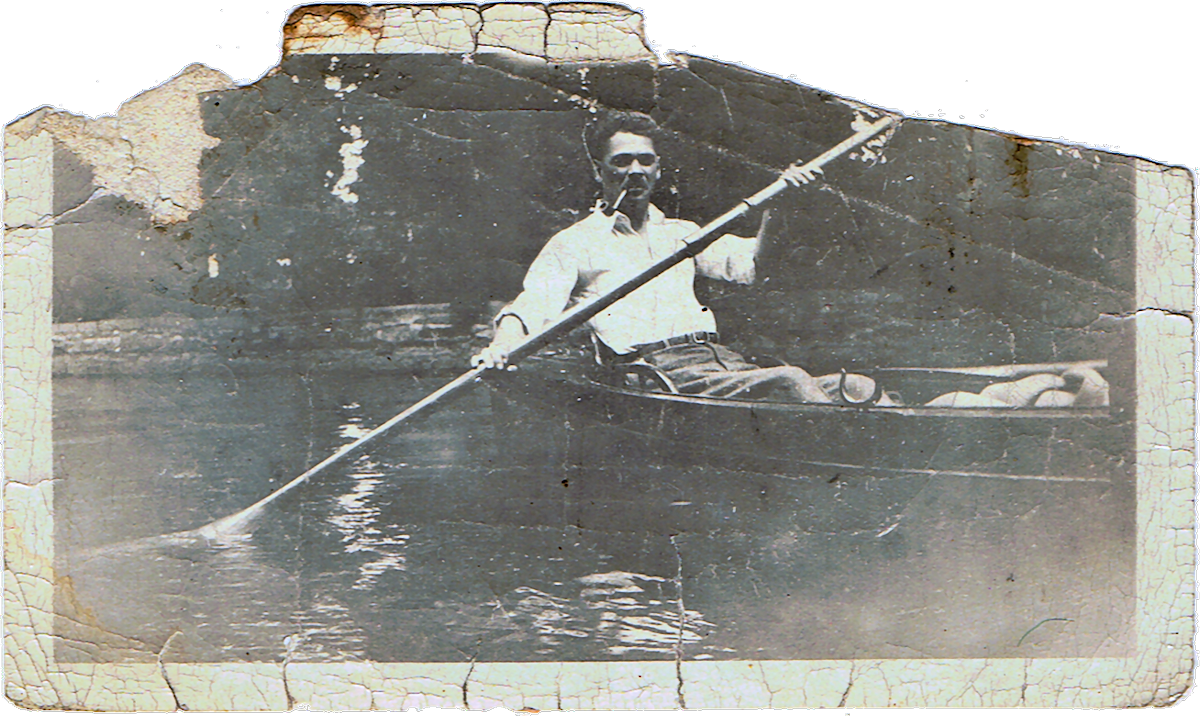
 RSW in canoe, 1920s. A photograph we suspect was taken by Helen and kept
RSW in canoe, 1920s. A photograph we suspect was taken by Helen and kept
in her personal items up till her death and later given to the Smithsonian.
We have three pieces of evidence pointing to canoeing as a shared activity. One is a
photograph in the Smithsonian Collection, of which Helen made a significant contribution to, of RSW, post-accident, in a canoe, on a body of water with paddle in hand we believe may have been
taken by Helen. There is also a reference in a letter to a piece of artwork included in a booklet made for, and sent to Helen titled, The Love
Leaf. The body of water being the same that RSW's father courted his mother years ago. Finally, on two occasions, there are reports from local papers of RSW vacationing on Lake
Casanovia in upstate New York just 90 minutes from where Helen grew up and we wonder if this place was special to the two friends in their time together in high school. That maybe the families
vacationed there together. Perphaps the photo of Woodward in the canoe is from Lake Casinovia? We do not know but we have also found photos from one of those trips to New York stuck in the
bindings of his books found in the Southwick studio. None of the picture show Helen herself nor do they show Woodward. However, one picture shows a man in front a waterfall we believe may be
Joseph Cowell.
Moving on, this bookplate for Helen is embued with many of the same sentiment and intimate qualities shared by the Window
Pictures of his latter career but it is not the only one. There are two others that possess the Window Picture quality:
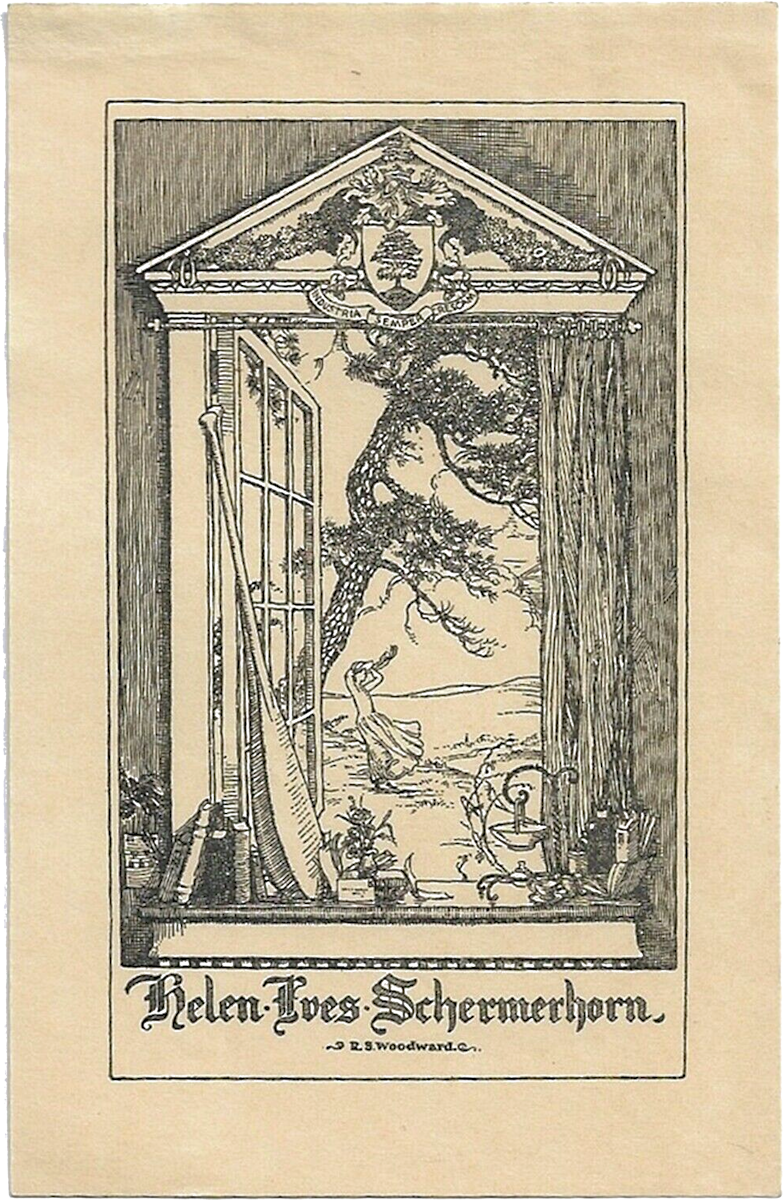
 Helen Ives Schermerhorn Bookplate
Helen Ives Schermerhorn Bookplate
in its entirety. Note how prominent
RSW's named appears and it use of his
preferred signature R.S. Woodward.
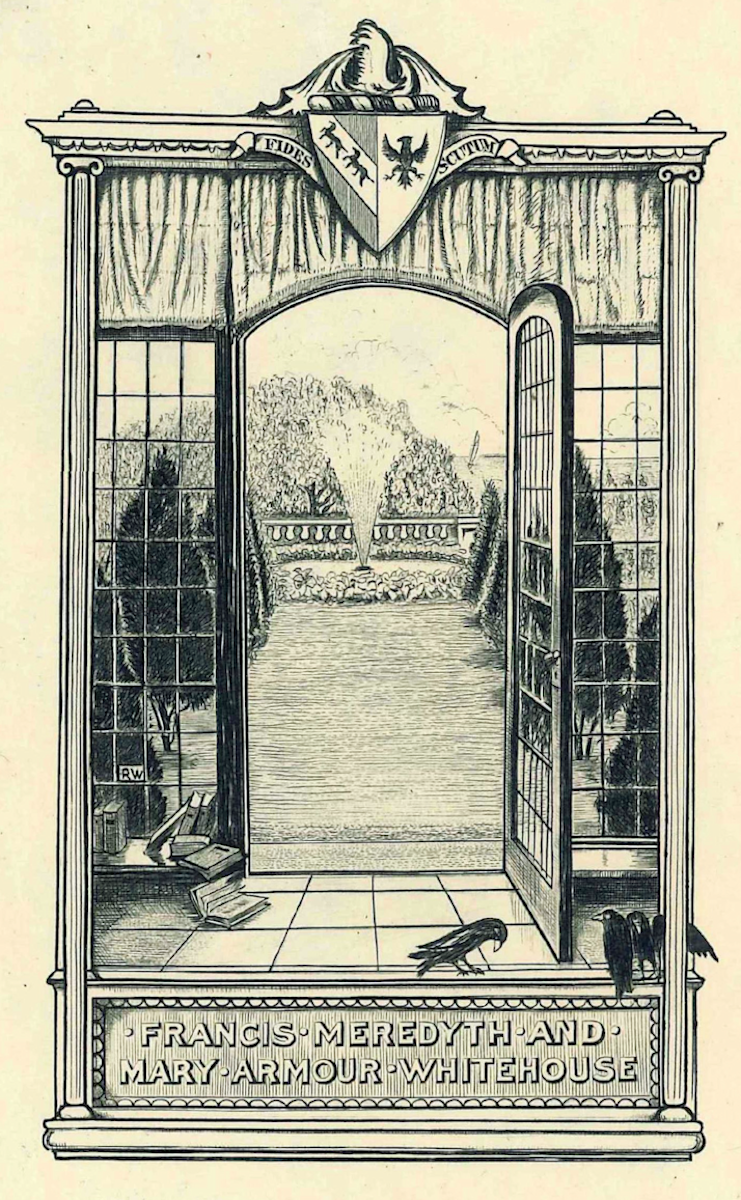
 The Crowhurst Bookplate
The Crowhurst Bookplate
made for the Pride's Crossing (MA) estate
of Francis
Merdyth and Mary Whitehouse
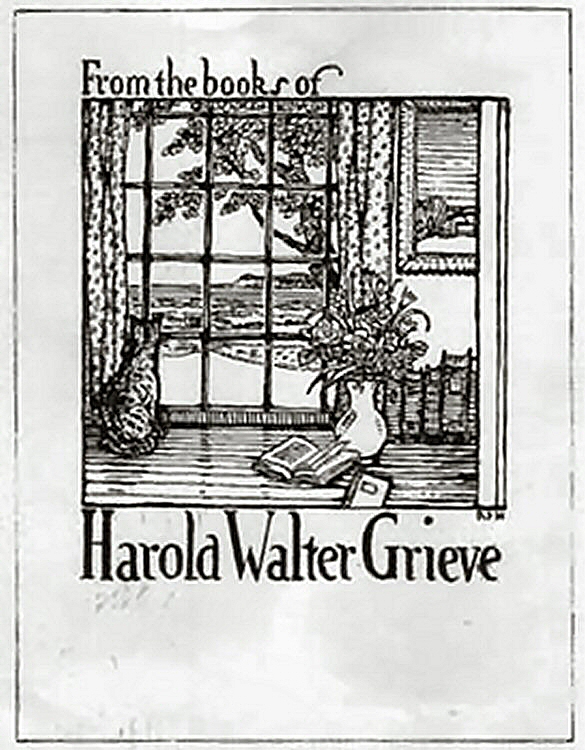
 Harold W. Grieve Bookplate
Harold W. Grieve Bookplate
made in the early 1930s for the Grieve's new home
in Hermosa Beach (CA) per Grieve's request. This
is another example of the personal nature of RSW's
Window Pictures. Only a good friend could get RSW
to do something he long left in the past.
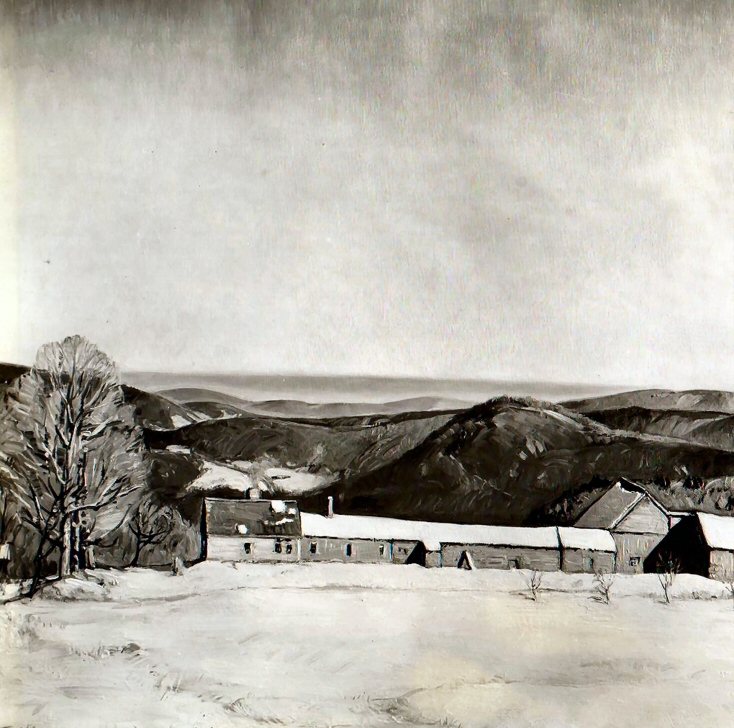
 Peace and Courage, Sepia
Peace and Courage, Sepia
Before Helen's bookplate Woodward first made the Francis Merdyth and Mary (Amour) Whitehouse bookplate for their new Pride Crossing (MA) estate Crowhurst. Much later, after he long left bookplates behind, Woodward designs a bookplate for his long time California friend Harold W. Grieve Bookplate. Though the Grieve Bookplate does not really qualify as an "early" bookplate because it could have only been made later in the 1930s when Harold and his wife Jetta Gould had actually moved to Hermosa Beach, CA. It still demonstrates Woodward's use of someone's personal interest and personality and pre-dates his Southwick years. We have the letters exchanged between the two long time friends. Grieve insisted the bookplate include his cat and the view outside his window of the shorline and water. Woodward again inserts himself into this bookplate. Note the framed painting on the right of the window... we believe that is Peace and Courage which Grieve had with him in California and is credited by Woodward for its name.
The Crowhurst Bookplate (1913-14) is of an atrium door overlooking a grassy path lined by trees leading up to a flower encased water fountain and terrace. In the distance, behind a wooded area ouside the terrace, one can see the Atlantic Ocean with a sailboat on its surface complimented with large billowing clouds on its horizon. This bookplate is rightfully included because it is reminicent of Woodward's balcony door paintings and even his unfinished Pasture House Studio window front with his tea terrace to the left and front window looking out towards the natural setting of his Beech Tree (fountain and/or sailboat for that matter ), its picnicing area surrounding the tree (a natural terrace) with the 'sea of hills' in the distance meeting the horizon of a big sky of billowing clouds.
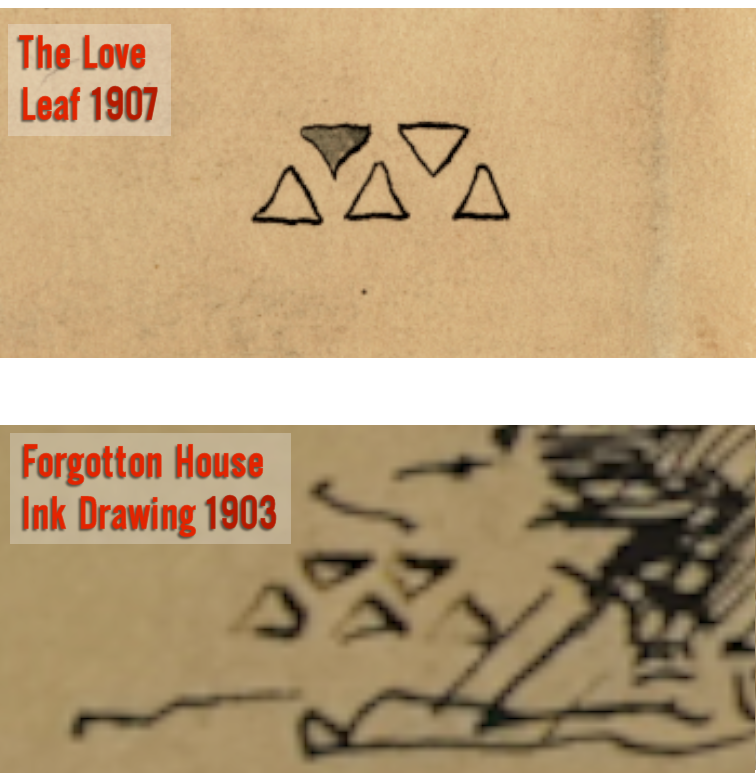
 The 5 Triangle Motiff / Logo, 1903 - 1908
The 5 Triangle Motiff / Logo, 1903 - 1908
The Top: The Love Leaf, 1907, and
Bottom: Forgotton House Ink Drawing, 1903
It is the personal nature of these bookplates which are closely aligned to that of a concept of and sanctity for home and
its comforts- in both body and shelter. But it is their revealing personal nature, what they represent, the value or virtue of something and extols the person connected to the design. Moreover, the ideal
of a logo held a strong fasination and appeal to Woodward. The Red "S" in his signature is a logo. Before his professional career, in a number of items sent to Helen he "signed" or marked the pieces
using a five triangle motif implying the shape of a "W". It could very well be that it is these qualities that attracted Woodward to bookplates in the first place. The idea of encapsulating the essence of
a concept, personalized, in a minimalist, symbolic form. Who are you in three words (symbols) or less. Woodward as strong. Helen, with a fortuitous wind...
Friend Lawrence Lunt, a bright light on a mountain.
We get just a hint of Woodward's pre-disposition to the artform of the Window
Painting in these bookplates. What has not been pointed out is that, though this element is not technically a window, many bookplate designs or even just this sort of graphic design device often
includes a border design which then acts as a window - a looking glass, glimpse or peak into something. Also see the:
Eugenia Beetle Herring, Curtis Eager Leonard and,
Lawrence Lunt bookplates for those examples. We wish we had more examples of Woodward's bookplates. We imagine most may be lost forever.
VISIT our page devoted to Helen to learn more about her relationship with RSW
( Page will open in a new tab)
VISIT our essay on RSW's attraction to the concept of Logos
( Page will open in a new tab)
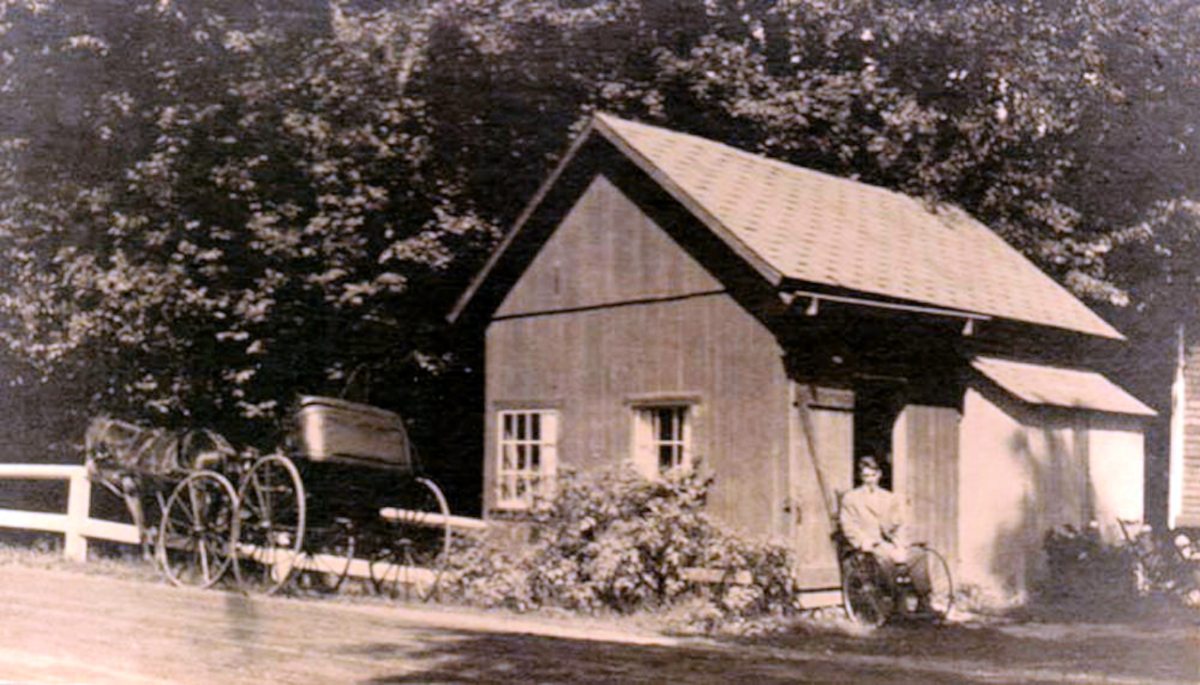
 Woodward in front of Redgate, early 1910s.
Woodward in front of Redgate, early 1910s.
Note the thick line of trees behind the studio.
Those are the interior woods he painted.
A QUIET PLACE: Alone with his Thoughts
After Woodward's accident with a revolver in September of 1906 that left him paralysed from the chest down. It goes without saying that his access to the larger range of travel options available to most were greatly reduced. He could no longer be unaccompanied on long trips to remote locations. He could no longer jump on a streetcar from downtown Los Angeles and head up to the mountains or down to the beaches in the Southern California area he lived. So the Window Pictures could also very well be his most private and personal paintings because they can be made in solitude while unattended. His meditations, where he could truly be with himself and express himself without distraction. And we do not mean meditation in the literal sense, sitting in lotus position and chanting "Ommmm...." We mean the kind of meditation one gets from knitting or doing some craft, artistry or even gardening... perhaps cutting wood?

 The Torii Gate
The Torii Gate
Speaking of meditations, we must discuss Woodward's first studio he named Redgate. Though there are no true Window
Pictures painted from inside the studio, its connection to the Window Pictures and their evolution cannot be overlooked. We begin with its name, "Red-Gate." We believe this is in reference to the
sacred structure of the Japanese Shogun and Buddhist religions called the Torii Gate. To pass through a Torii Gate is to enter "sacred ground." They stand as guardians in front of all temples of worship.
Woodward greatly admired Japanese art and culture and by his own account studied both Hindu and Buddhist philosophies (cyclopedia of American artist where the artist supplies the information).
You may ask, "What would Woodward know of the Torii Gates of Japan?" He first fell in love with Japanese culture as a student in Peoria, IL. When he moved to Los Angeles in the summer of 1906,
LA held the largest population of Japanese outside Japan after San Francisco's devastating earthquake the Spring of the same year. Furthermore, he lived just a couple block from the Little Tokyo
section of the city and was set to visit Japan in a couple just weeks until his tragic accident spoiled those plans. We also have a Japanese ink wash drawing on crinkled rice paper with a label from a
shop on 7th Street near Westlake Park and the Good Samaritan Hospital he spent three months
recovering from his injuries.
sidesLG.png?url=photos/Studios/redgate_studio-late_period-east(south)sidesLG.png)
 The east and south sides of the Redgate Studio looking west.
The east and south sides of the Redgate Studio looking west.
It is hard to see but there are two windows on the eastside of the studio,
one by the front door and another from the rear add-on in the back.
sideLG.png?url=photos/Studios/redgate_studio-period_unknown-west(south)sideLG.png)
 The west and south sides of the Redgate Studio looking east,
The west and south sides of the Redgate Studio looking east,
the backside of the studio closest to the woods. You can see the
southwest corner window where RSW may have painted from...
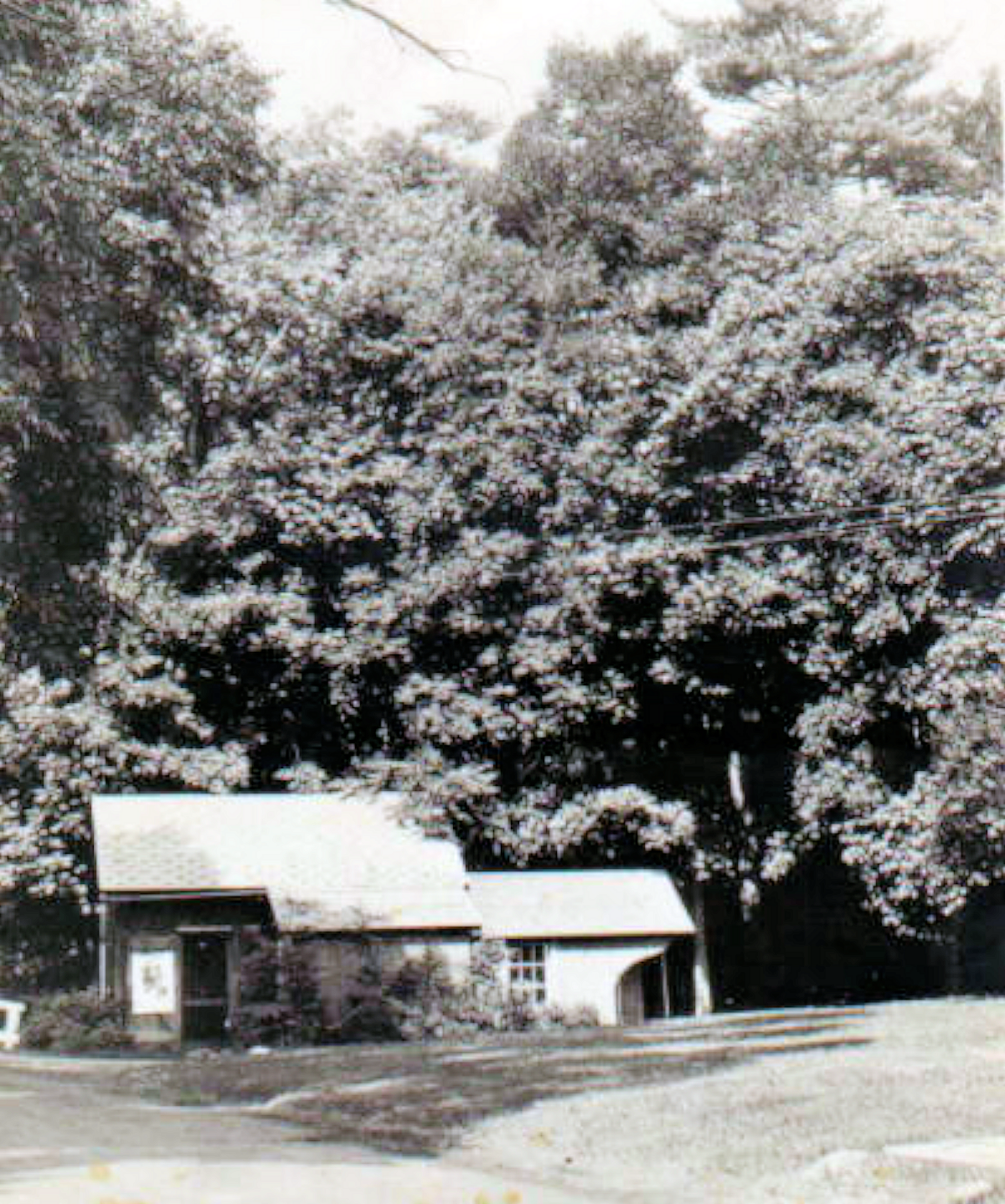
 A distant photo of Redgate looking west.
A distant photo of Redgate looking west.
This picture best shows the rear of the place. Note
how close the woods almost consume the studio.
What is quite particular to the Torii Gate and relevant to this discussion is that in Japanese tradition they are almost exclusively painted red. You will find some white ones (the original gates were white), but red is by far the most prominent color choice. If you search "Red Gates" online, the Torii Gate will appear almost exclusively. Both colors represent similar metaphorical meanings with slight differences. Red symbolizes vitality and protection in the East. Protection from what? Well, the Torii Gate is traditionally considered a portal to the spirit world and the protection is against evil. With the exception of the Heath Pasture House / Studio ALL of Woodward's home studios were painted red.
The spirit world in the East, in the most general terms, would be one's inner-world. One's interior, on a quantum level - the unconscious. It is a place of reflection. One which is outside the awareness of consciousness. It is a dangerous place for even the initiated, thus the need for protection. It is the unseen, invisible nature of space outside the distraction of time. It is deep space. A place one can easily get lost if untethered. Mysterious and unpredictable (prior to the knowledge of quantum mechanics- Einstein, or even, Freud and Jung) and in many ways, reflects the figurative looking glass through which Alice enters Wonderland or Gulliver finds himself in the four lands of multiple perspectives and Dante's journey through the inferno.
You can see the woods are right up to the edge of Redgate. This is what we love most about Woodward and how he is
SO good at taking the literal and elevating it to poetic heights. What is in a name? Woodward will tell you because he takes both his mother's namesake, Strong, and spends his career illuminating
us with what he believes true strength really is and that it is everlasting. His father's name, Woodward, here quite literally means "warden of the woods." What is a warden? A protector! But is also
literally the term for a particular type of medium armor worn in the middle ages and made from strips of laminated greenwood that flex with the wearer's movement but stiffens when struck in battle.
In the East, wood is the symbol of character. This wooden-armor is both flexible but stiffens when necessary. How much more literal can one get; past the red gates of protection wearing his namesake,
a wooden- armored suit. There is just so many layers and dimensions to its metaphor we can't possibly cover it all in this format.
Woodward on literal-ness:
"It is reported to me that the work was felt to be too 'literal' and lacking in 'freedom'. As for the first word, the outlook does not begin to be as literal as that of Ben Foster, for example, -- but has what his work never has owned, a strong and seriously thot out sense of design. Upon close inspection, the point of view is not so literal in my work, after all, but all is expressed so powerfully it gives that effect - yes, perchance too powerfully."
Woodward to NYC gallery owner, Robert W. Macbeth, 12 October 1920, from "Redgate"
 All of the emphasis is ours...
All of the emphasis is ours...
 Ben Foster is a popular late 19th and early 20th century Tonalist artist from Maine.
Ben Foster is a popular late 19th and early 20th century Tonalist artist from Maine.
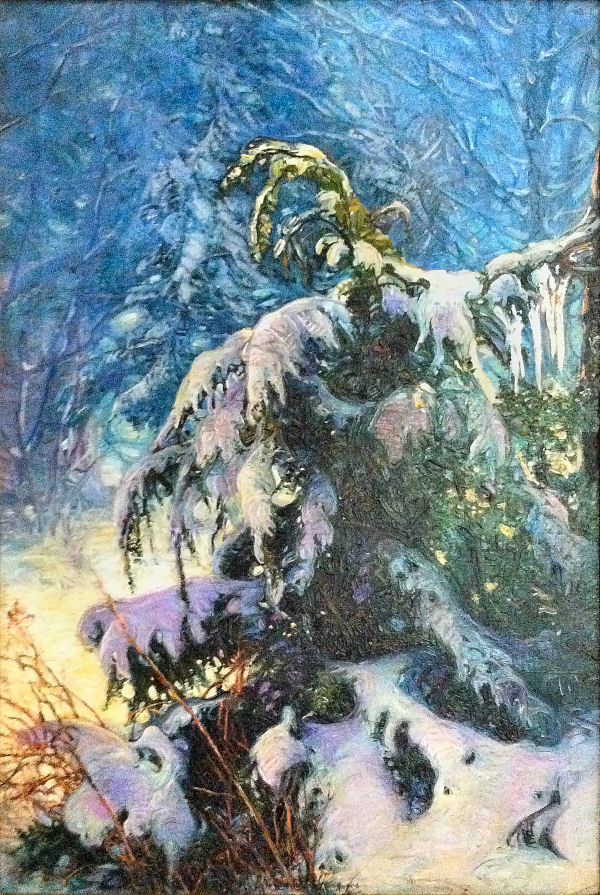
 Small Hemlock in Snow
Small Hemlock in Snow
Even the perspective of this painting, nar-
row and upright, feels very rectangular and
similar to the shape a door would have.
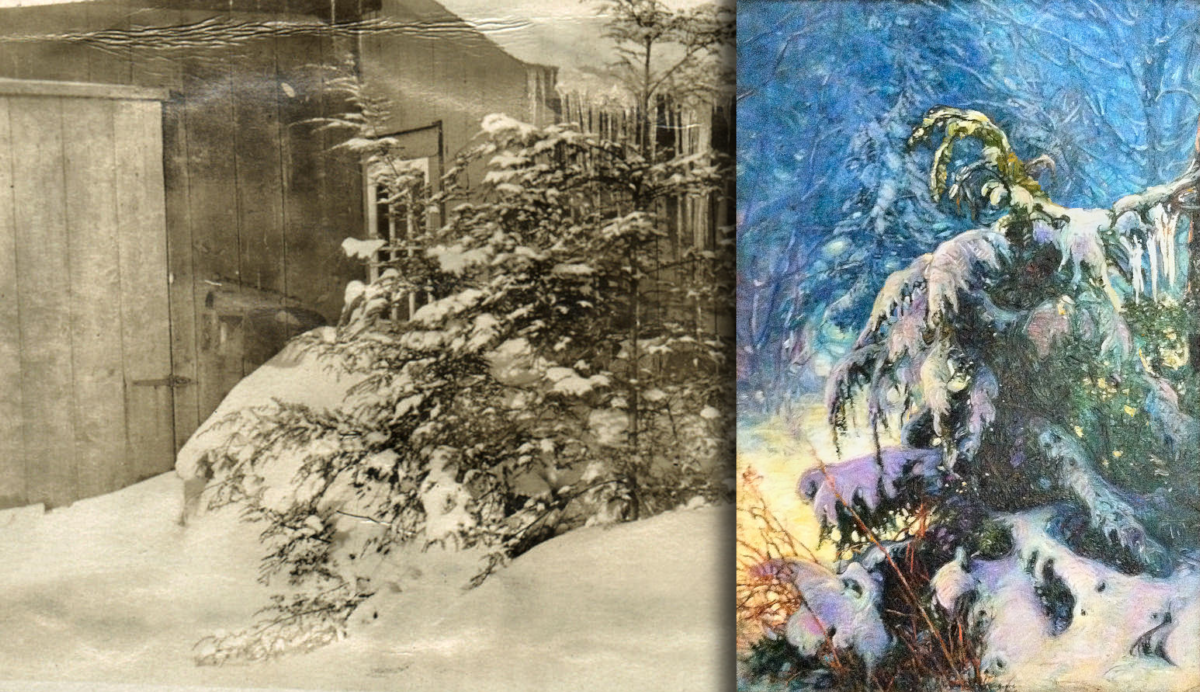
 A side by side look at a photograph of the small
A side by side look at a photograph of the small
hemlock right outside the studio door he also
painted lit by the outside lantern that hangs on a
hook not seen in this picture but can be in others.
Furthermore, most of Woodward's interior-woods paintings made from Redgate were made at dusk. Dusk is
traditionally seen with mystery. It is the misty portal into night and darkness. More importantly it is a "phase transition." In physics there is not an intermediate place between liquid and solid.
It is or is not one or the other state, but dusk has the reputation of a time "between" worlds or other-worldly. Where energies of day and night mingle, merge if just for a few brief moments.
Dawn simply is not regarded with the same kind of reverance mystically. And again, we have a theme of an emergence or marrying of opposites (things that would not normally meet).
It is not always considered in this way but most all of Woodward's dreamy, dusk-time, woodscape interior paintings where often made from the front stoop of his Redgate studio or just
outside its back door (the gateway). [Enlarge the image to the left] Even the fact that many of the paintings are at dusk almost suggest he waited for his nurse or attendent to leave for the
day before he went to work on them. In this context, the quintessential Redgate paintings become part of the early development and evolution of the Window Picture painting.
The quintessential Regate painting reflects the solitude we all use to comtemplate our future. Only Woodward's solitude is one of peace and a state serenity often found in such quietude. Something, perhaps, he felt more profoundly than most. There is a quiet confidence and promise. He relished his alone time because he had so little of it. Going back to the literal, consider the names of some of these paintings that suggest the intimacy from which they were made: The Portal (perhaps the most literal of them ALL). Then there is Silent Evening, Evening Tranquil Hour, The Tranquil Hour, Out of the Mist, and Winter Mist. He is going to a special place within, in order to find himself. Make new discoveries. He is traveling the realms... Clearing his mind and participating in an alchemical process.
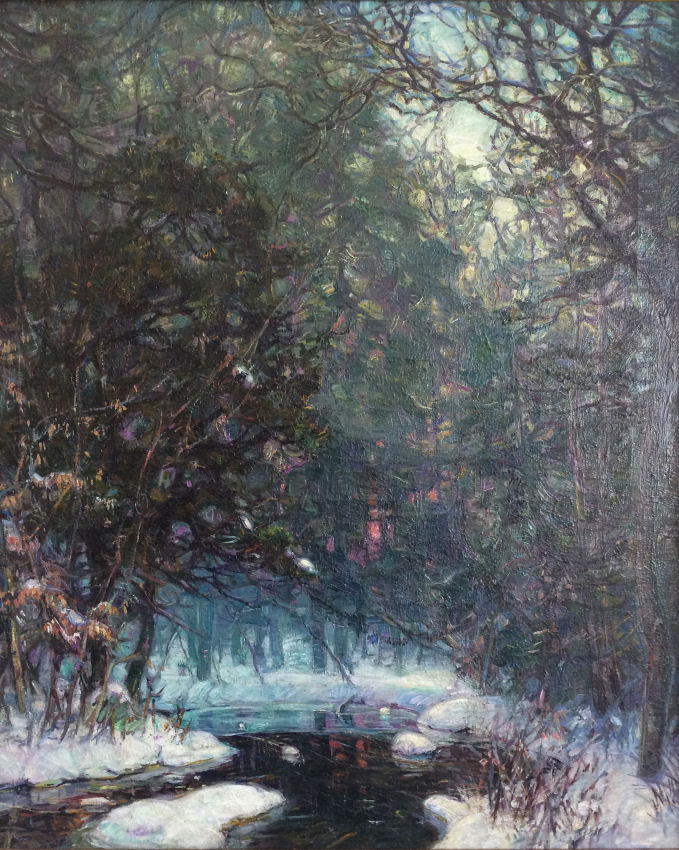
 The Tranquil Hour is quintessental
The Tranquil Hour is quintessental
Redgate. Snow on the ground, early evening
woods, moonlight peaking through the branches
reflecting off a placid, partially frozen pool of
water found just behind the studio.
This is a transitional phase for Woodward, in that, he is moving from commercial
art to professional landscaping. The sincere, intimate, and detailed approach translates to the canvas and would also become the bedrock of his method in sincerity and intent. It would win him
one of the highest honors of his life, First Prize of the Hallgarten Award at the NAD in 1919, just two years into his professional career. It may
even be that Woodward started painting these kinds of exteriors while still a commercial artist, before completely committing himself to painting landscapes in April of 1917.
Alone, with his thoughts at a time when he was talking stock of his life and entering a new phase appears to be the crux of the Redgate painting and Window Picture paintings in general. Though he
has yet to paint his first Window Picture at this time in his life. The relationship between the interiors of the dusky-wooded Redgate paintings and his later Window Pictures paintings reveals itself
in their common qualities: (1) from his home, (2) when he was most likely by himself with his thoughts, and (3) using what is immediate to him to create. Each instance where the Window Picture
first appears at various chapters of his life coincides with a time when he is navigating a change or transitional period in his life and so the introduction of the concept of "phase transition" becomes
critical to understanding what is behind Woodward's motives for the Window Picture and the critical mass of their evolution.
Take some time to consider this - Think of each and every wooded interior Redgate painting as a bookplate. A window into Woodward's mindset and inner space. What he valued above all else. The three word game: Mist, Silent, Tranquil. Now consider other key words from his later paintings, such as, Peace, Dignity/Grace, and Strength. Not a bad summation of Woodward after all is said and done. Lastly, we now ask you to consider the image and importance his favortie subject, snow. Of all the climates and conditions possible, only snow possesses all of these qualitites. Nothing stops the world in its tracks or dampens the noise like snow. It is also "other-worldy." More profound than any of that is how he somehow taps into what may be an undercurrent of consciousness. He was making these atmospheric, ascending to the poetic scenes before poet Robert Frost published one of his most well-known and popular poems, "Stopping by Woods on a Snowy Evening" (1923). The poem is one of taking a brief respite in a familiar place as one is on a long journey. Note the last stanza's message:
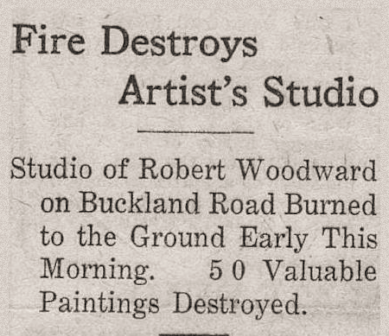
 23 Dec. 1922, Shelburne Falls Transcript
23 Dec. 1922, Shelburne Falls Transcript
Two days before Christmas, RSW lost his
most sacred place derailing his career for
3 years between illness and financial woes.
"The woods are lovely, dark and deep,
But I have promises to keep,
And miles to go before I sleep,
And miles to go before I sleep."
In one of the most unfortunate events in his life, after quite a bit of negotiation, Woodward has a chance to make his premier One-Man Show at the famed Macbeth Gallery in New York City known for featuring distinctly American artwork and artist. He has prepared 50 paintings for William Macbeth to chose 25 from the bunch. Stored in Redgate, Woodward feared the paintings might freeze the night before being picked up to be shipped so he had extra wood added to the wood stove. We he did not anticipate was the cramped space becoming super-heated with numerous flamible chemcials in the room with relatively low flash-points in glass bottles. The cumbustable situation turned tragic as the studio ignited into flames and all but one painting was lost, now remember the Frost poem-- "promises to keep... And miles to go before I sleep."
VISIT the Quintessential Redgate Gallery
( Page will open in a new tab)
In history, there is a period of time commonly known as "The Dark Ages." A time before the Renaissance (the time of Enlightenment) which is considered a backward times, a reversal or regression. But science today is proving that the Dark Ages were more advanced than initially believed and many of the ground breaking thought and art of the Renaissance actually originated in the Dark Ages. The Dark Ages were brought on by the collapse of the Roman Empire when entire social and cultural structures fell apart leading to a period of confusion and adjustment. The four years following Woodward's Redgate fire would be the Dark Ages that lead to his own Renaissance, perhaps more painfully so than the accident that left him paralyzed. It is the event the produces the most visible and significant changes in the man and his approach.
A DARK PLACE: With Just a Glimmer of Hope
Besides Woodward's personal life being in tatters, his professional reputation is in ruin as well. It is not just
that Macbeth will hold a grudge against Woodward for nearly a decade but for all intents and purposes, the word spreads. It is 1925 and Woodward's friends and patrons are trying to
raise money ($8,000 which in today's dollars is roughly $120,000) in the form of a fund raising letter to prominent individuals. The letter claims, he had suffered a long illness and that
he was only making half his monthly bills.
Since the fire he has only exhibited seven paintings at six locations. Of those locations two were at the Salmagundi Club in '23
and '24 where he was a member and one at the National Academy of Design in New York City. We also learn from the fund raising letter that he has a six 40" x 50" paintings that could
be purchased, "if they prefer." We have a good idea of what three of those paintings are: The Portal (1918),
Out of the Forest (1919), and Through the Night
(1920), all of which remained in the estate of the artist to his death in 1957.
What is interesting about the letter is how the it is phrased. It is a campaign letter. It needs to be worded
carefully, especially when you are asking for money. We feel like it is a big omission to not specifically say the large paintings are for sale. Instead the letter says, "Should anyone prefer
to buy one of his pictures..." which suggest to us Woodward would rather NOT part with the paintings because he is partial to them. They are all he has left of Redgate, he is still morning
the loss.
Making matters worse, the letter offers
a weak excuse why the artist is not selling them in a gallery stating, "...on account of their size, are not readily saleable at a dealers at present." But then, to end the letter, it mentions
seven smaller paintings (36" x 42"), "Any or all of these he would be very glad to sell." There is not a significant difference in size, less than 500 square inches separate the two and why
not mention the smaller paintings first? Would it not make sense that people would be more likely to buy the smaller paintings Woodward was willing to sell? We suspect that this is a
difference of opinion between the artist and the letter's author Dr. Lawrence Lunt. Lunt sees a greater urgency than Woodward
who is being perhaps a little stubborn in his embarrassment to let go of what where most likely dusk-time, interior wood paintings from Redgate he most prized and hung in his house.
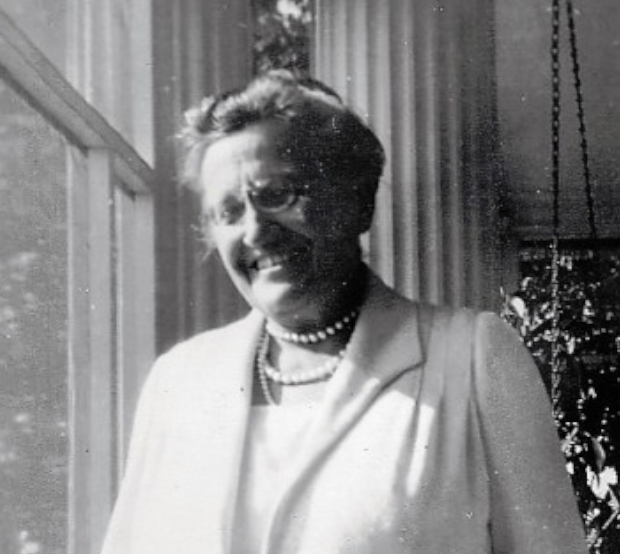
 Mrs. Ada Moore, Woodward's
Mrs. Ada Moore, Woodward's
patron and sponsor since the mid-1920s.
Speaking of houses, at the time of the fire, Woodward was already living in the main house of his Hiram Woodward Place property. He had been renting the main house since 1917 after living a couple years in the Burnham Cottage on the property's western edge. After the Redgate fire, he bought the long neglected farm in May of 1923 with the help of family and friends (also mentioned in the the fund raising letter). Now that he owns the property he can do more to fix the place up and now use the large shed behind the main house where he will build out his new studio. He would also fashion it to his specific needs, including an artists' north window, his first.
This period of time would not be the first when Woodward would get sick during a time of low finances. We believe, and alluded to in the first section of this essay, that is what may have led to his illness when he was a student in Boston and while he will have bouts of illness, primarily digestive, which would plague him throughout the rest of his life. This would be the last time he would get sick for that reason, because what is in all likelihood the result of the fund raising letter, Mrs. Ada Small Moore would now assure his medical concerns would no longer put him in despair. Mrs. Moore would set up a trust to cover all of his medical care, including a full time nurse and attendent, for the remainder of his life. She would also supply him with automobiles from which he can paint, although his first car, a 1924 Studebaker, was a bit sportier than the touring cars of his later years... he made due nonetheless.
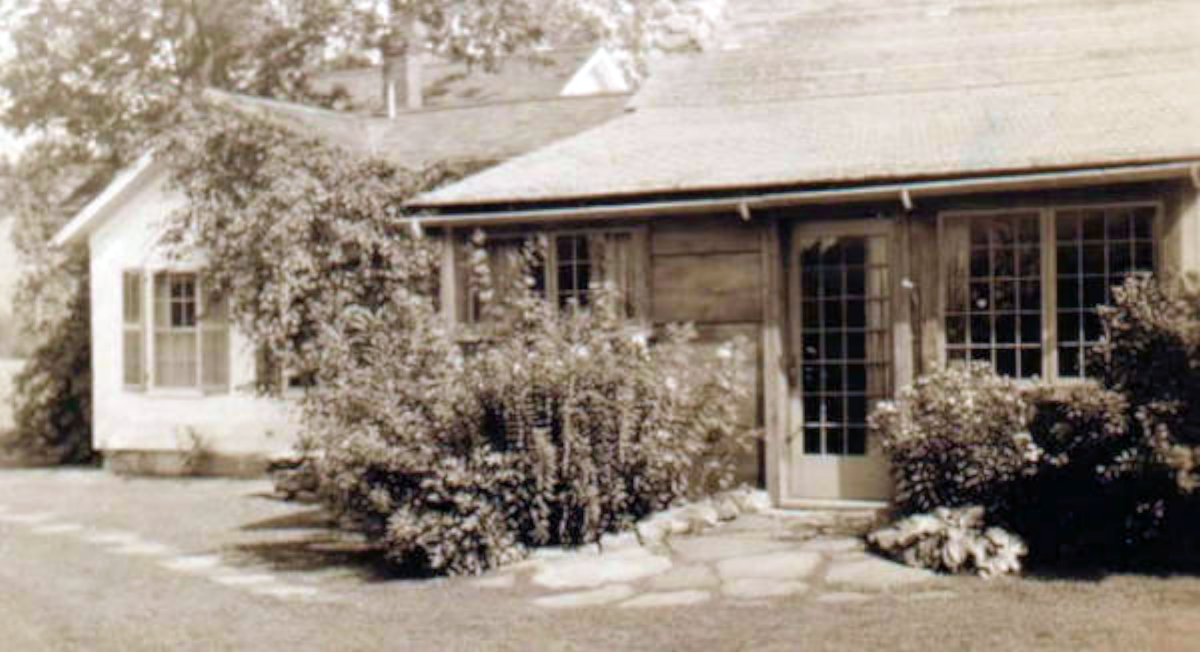
 The Hiram Woodward Studio and home looking northwest.
The Hiram Woodward Studio and home looking northwest.
Note the two, book-end corner windows. Around the corner
from the one to the left is a 22-pane Artists' North Window.
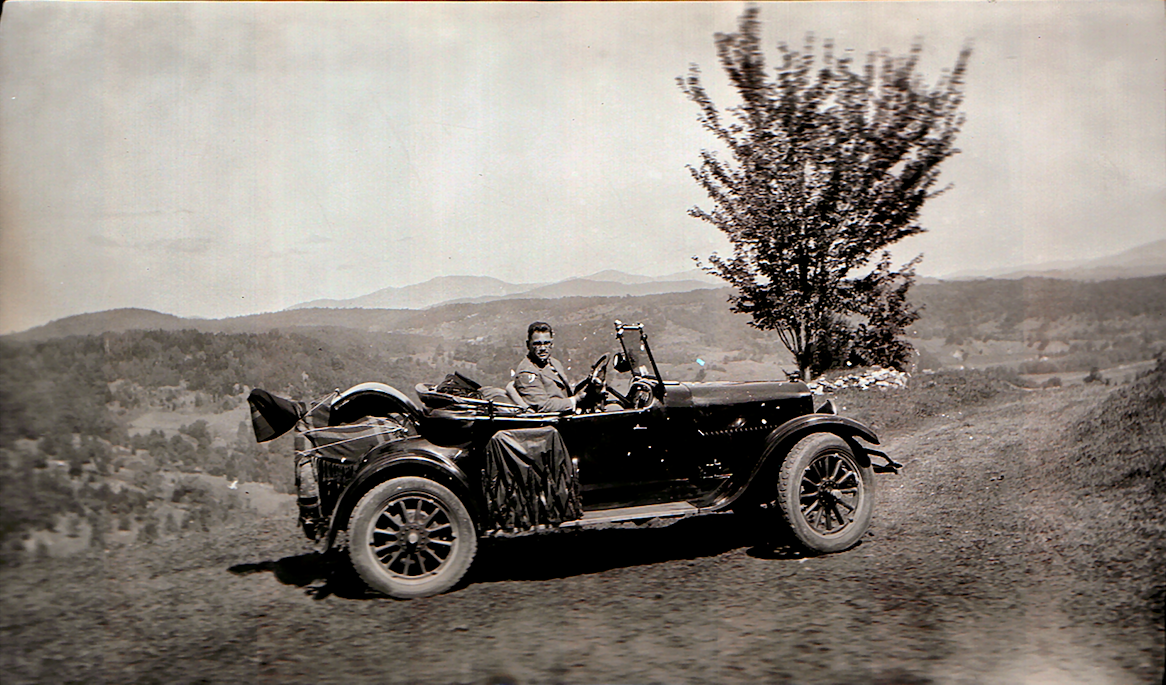
 Woodward sitting in his 1924 Studebaker Light Six.
Woodward sitting in his 1924 Studebaker Light Six.
Enlarge the picture to see how packed it is! And also check
out our essay Car Troubles about RSW's vehicle mishaps.
This is a significant event in Woodward's life. For the first time since he set out on his own in 1908, the playing field is now level for him meaning he does not have to earn twice and possibly three times the money of other artist to keep his head above water. That his new studio with a north window and the new capability to travel greater distances in shorter times has a pervading impact on his work as well. He can take greater risks and paint in a technique distinct to his own original, self-taught style rather than copy what is popular. It gives him the freedom to follow his own path and he takes full advantage of that liberty with dramatic changes to his style and subject matter from 1924-'25. He does quite a bit of experimenting to find his way and those new windows in his new studio play a big role in inspiring him.
_____________________________________________________________________________________________
It does actually take Woodward nearly two years from the time that the fundraising letter goes out to prospective investors from him to put together exhibit-worthy work. To be more precise, one year and eleven months from the date of the postmark he will re-launch his career featuring 26 paintings, 25 oils and one chalk. However, it is not on a stage one would expect. It is not a gallery. He will not have an agent, in fact, his cousin Florence, a resident of West Newtown, MA will act as his business agent for the show suggesting that a lot hinges on the success of this exhibition. His greatest advocate, Millie Eliot, and her friends will do all they can to stack the deck and the Window Picture painting will be the face of that success.
Coming soon, Part II: We will pick up where Part I leaves off- Woodward's first One-man Show and the details
of the event and how the Window Picture painting became the face of the show. We will then introduce the Hiram Woodward studio discussing the reasons Woodward may have turned to the
Window Picture painting, and the others that followed, including the only true Still Lifes of his career and other "interiors" he painted only in this period of time... Part II is almost finished and
it will not be long before we publish it.
BCM, June 2023

